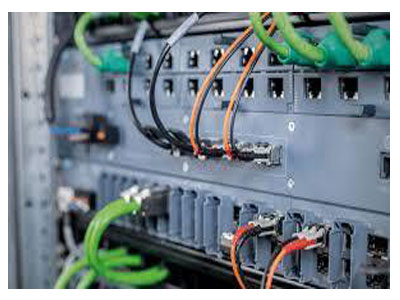Key Takeaway
Automotive Ethernet and Industrial Ethernet are both Ethernet-based technologies, but they serve different purposes. Automotive Ethernet is designed specifically for vehicles, enabling high-speed communication between components like sensors, cameras, and control units. It is lightweight, cost-effective, and optimized for in-car networks where space and energy efficiency are crucial.
Industrial Ethernet, on the other hand, is built for rugged industrial environments. It connects machines, controllers, and sensors in factories or plants. Industrial Ethernet focuses on reliability and durability, handling extreme conditions like heat, dust, and vibrations. While Automotive Ethernet is tailored for in-vehicle systems, Industrial Ethernet is suited for automation and large-scale industrial networks. The key difference lies in their applications and environmental requirements.
Introduction to Automotive Ethernet: Use Cases and Applications
Automotive Ethernet is a specialized form of Ethernet designed to handle the unique requirements of modern vehicles. It supports fast and reliable communication between a car’s internal systems, such as sensors, cameras, infotainment, and Advanced Driver Assistance Systems (ADAS).
Its main advantage is the ability to replace traditional wiring systems like CAN and LIN networks, reducing weight and cost while enhancing speed. With data rates of up to 10 Gbps, Automotive Ethernet enables real-time transmission of critical data, such as collision avoidance alerts or live navigation updates.
Automotive Ethernet also supports advanced technologies like autonomous driving and vehicle-to-everything (V2X) communication. These capabilities are essential for the next generation of smart and connected vehicles, ensuring safety, efficiency, and seamless integration of advanced systems.

Use Cases and Applications H2: Comparing Data Transmission Speeds and Protocols
When it comes to data transmission speeds, both Automotive and Industrial Ethernet offer high performance but differ in implementation.
Automotive Ethernet typically operates at 100 Mbps to 10 Gbps, focusing on high-speed communication for time-sensitive tasks within vehicles. Protocols like AVB (Audio Video Bridging) and TSN (Time-Sensitive Networking) ensure low latency and synchronized communication, which is critical for ADAS and infotainment systems.
Industrial Ethernet, on the other hand, also supports speeds up to 10 Gbps but emphasizes real-time control over massive networks. Protocols like PROFINET, EtherNet/IP, and Modbus TCP are designed for precise timing and high reliability in manufacturing, energy, and other industrial sectors.
While both achieve fast data transfer, the priorities differ—Automotive Ethernet focuses on internal vehicle communication, whereas Industrial Ethernet supports large-scale, interconnected networks.
Comparing Data Transmission Speeds and Protocols H2: How Automotive Ethernet is Designed for In-Vehicle Networks
Comparing Data Transmission Speeds and Protocols
H2: How Automotive Ethernet is Designed for In-Vehicle Networks
How Automotive Ethernet is Designed for In-Vehicle Networks H2: Industrial Ethernet’s Role in Harsh and Rugged Environments
Industrial Ethernet is built for reliability and durability in extreme environments. Unlike Automotive Ethernet, it must withstand conditions such as high temperatures, vibrations, dust, and moisture, making ruggedized components a necessity.
Industrial networks are often large and complex, connecting thousands of devices like sensors, controllers, and actuators. Industrial Ethernet excels in handling such networks, offering real-time communication, scalability, and robust diagnostic tools to ensure minimal downtime.
Protocols like PROFINET and EtherNet/IP support precise synchronization for tasks like robotic control or conveyor belt systems, where even minor delays can disrupt operations. Additionally, features like redundancy protocols ensure uninterrupted communication, even if part of the network fails.
In industries like manufacturing, oil and gas, and power generation, Industrial Ethernet ensures seamless operation in challenging environments, prioritizing uptime and reliability.
Industrial Ethernet’s Role in Harsh and Rugged Environments H2: Choosing Between Automotive and Industrial Ethernet Based on Application
The choice between Automotive and Industrial Ethernet ultimately depends on the application’s requirements.
Use Automotive Ethernet for internal vehicle communication, where lightweight cabling, low latency, and high-speed data transfer are critical. It’s perfect for ADAS, infotainment, and autonomous driving systems.
Use Industrial Ethernet for large-scale industrial networks requiring ruggedness, scalability, and compatibility with real-time control systems. It’s ideal for factories, energy grids, and other harsh environments.
While both Ethernet types share similarities, their unique designs and features make them suitable for vastly different scenarios. Selecting the right one ensures optimal performance and reliability for your specific needs.
Conclusion
Automotive and Industrial Ethernet serve distinct purposes, each excelling in its domain. Automotive Ethernet is tailored for efficient, high-speed communication within vehicles, supporting advanced technologies like ADAS and V2X. Industrial Ethernet, on the other hand, focuses on robust, scalable communication in harsh industrial environments.
By understanding their strengths and limitations, you can choose the right Ethernet type to meet your application’s requirements, ensuring reliable performance and long-term efficiency. Both technologies are integral to modern innovation, driving progress in their respective fields.
